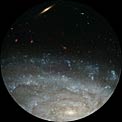The release date of this Hubble image was September 4, 2003, so it is a golden oldie.
This is the sort of image whose color information I personally find a bit hard to read. In an RGB image, you would have expected to find red emission nebulae, which would have made it much easier to pin down where most of the star formation was taking place. Also, if you used broadband filters, the color variation over the face of NGC 3370 would probably have been greater, making it easier to judge the ages of the various stellar populations.
Of course this picture was made in order to identify individual Cepheid stars, which makes resolution a top priority. I don't know if a similar level of resolution could have been achieved with broadband filters.
My favorite link was one of the "NGC 3370" links, the one that is five lines down from the top and four lines up from the bottom. This link had a very nice zoom function.
I searched the net for alternative images of NGC 3370, which might offer an alternative view of the color of NGC 3370. I searched in vain. Unfortunately, when Hubble has taken an image of a galaxy, this image is often seen as the "definite" image of this galaxy, so that no other pictures are needed. The thumbnail picture I'm posting here is one of the most "alternative" images I found.
Let me try, nevertheless, to describe the appearance of NGC 3370 in today's APOD. We may note that the yellow nucleus is small. Confusingly, the surrounding bulge is very ill-defined. The bulge can be identified in the zoom-in picture as the inner region where the individually discernible bright stars disappear. In the bulge, there is a "smooth population", which, confusingly, is quite similar in color to the outer arms. Both the outer arms, which are full of hot blue stars, and the smooth inner bulge, which consists of large numbers of evenly distributed faint to medium bright stars, are a sort of greenish-blue in color. The main color difference is that the greenish-blue hue is "clearer" in the outer arms, whereas it is "dirtier" and more mixed with dust in the bulge. Spiral dust lanes (or dust arcs) wind all the way down to the nucleus, and the bulge is full of these dust arcs.
It could be that NGC 3370 recently - say, perhaps, less than a billion years ago - formed a lot of stars in what is now the bulge. This vigorous star formation in the bulge region has now left behind copious amounts of F- and G-stars, which are responsible for the surprisingly non-yellow color of the bulge. (And speaking of "the bulge", by the way: the bulge seems perfectly flat to me, as if it isn't bulging at all.)
I'm glad this image of this galaxy could help Adam Riess, this years Nobel Prize winner in Physics (along with to other recipients) to pin down the expansion rate of the universe.
Ann
 Spiral Galaxy NGC 3370 from Hubble
Spiral Galaxy NGC 3370 from Hubble
